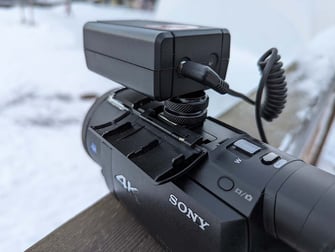How to use Dish for accurate video and data syncing
Dish is a device that generates an audio time code (Linear TimeCode or LTC) from the GNSS satellite network. Just plug it in to your camera's microphone port and turn it on.
Dish is a device that uses GNSS (GPS, Galileo, GLONASS, BeiDou) satellites to generate an extremely accurate audio time code. This audio signal is added to video via the camera's microphone input. The audio time code is read by video software such as Dartfish and Telemetry Overlay to precisely line it up the video with collected Protern Sensor data.
Table of contents
- Requirements
- Mounting Dish to a camera
- Recording your video with Dish
- What do Dish LEDs mean
- Frequently asked questions
Requirements
- Dish device
- 2x AA batteries
- 3.5mm audio cable
- (optional) Hot shoe mount
- Camera with a microphone input
Mounting Dish to a camera
- Locate your camera's hot/cold shoe mount
-jpg.jpeg?width=311&height=233&name=Canon_350D_Hot_Shoe%20(1)-jpg.jpeg)
- Screw the hot shoe adapter into the bottom of the Dish and use one of the two nuts to secure the Dish
- Slide the adapter into the camera's hot shoe mount and use the other nut to secure it to the camera

Recording your video with Dish
- Plug the audio cable into the Dish and the camera's microphone port
- When outside, turn on the Dish by pressing the button beside the Dish's audio jack.
- Dish is ready and sending a time code when the LED is flashing green. (What do the different LEDs mean?)
- Film your athletes
What the Dish LED lights mean
The Dish LED is located on the power button.
- Blinking Green: Good satellite signal; Good battery
- Blinking Yellow: Good satellite signal; Low battery
- Blinking Red: Good satellite signal; Replace battery soon
- Solid Red: No satellite signal; Not ready for filming
- Solid Yellow: Weak satellite signal; Not ready for filming
- Solid Green: Good satellite signal; Starting audio time code
Frequently Asked Questions
- How long do the batteries last?
Two fresh AA batteries will last for about 40 hours of recording - Does it work inside?
Dish is best used outside in view of the GPS satellites. However it is possible to use it inside.
Dish needs to get a satellite signal from outside. After it has a satellite lock, it has a high-quality internal clock to keep accurate time when it cannot see any satellites. - How long does it take to get a signal?
Up to 5 minutes the first time, or after you've travelled some distance from the last time you used it. Normally it will take less than 30 seconds to get a satellite signal. - Should I turn it off after I film each athlete?
We don't recommend it as it is possible you may forget to turn it back on. The batteries last 40 hours, so it is likely easiest to keep it on during a training session and just turn it off if there's a long break (i.e. lunch). - The audio time code is really loud. Is there a way to play back the video and just hear the commentary from the Dish's microphone?
Yes. Dish records the audio time stamp on the left stereo channel and the internal microphone on the right channel.
Here are some ideas: When playing the video back, just use the right earphone. Another option is using VLC Player's (download for Windows or Mac) option to mute the left stereo channel when - My camera doesn't have a hot/cold shoe mount, can I still use Dish?
Yes. You will need a long enough audio cable to reach from your camera to the Dish. The Dish ideally has a clear view of the sky, but once it has gotten a satellite signal (i.e. LED is flashing green), it could go into a pocket. - My camera doesn't have a microphone input, can I still use Dish?
Dish needs a microphone port to play an clean audio time code that can read by software like Dartfish and Telemetry Overlay.